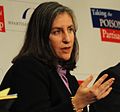Hillaryland
Hillaryland was the self-designated name of a group of core advisors to
The group included
Almost all are women; the only man in the group was former First Lady deputy press secretary Neel Lattimore. Most worked in the
The advisers were also present during
After she ended up losing the 2008 Democratic nomination, critics often focused on the limited and isolated circle of advisers and dysfunctional management style as one of the reasons behind the campaign's failure.[8][10] One criticism was that she valued personal loyalty over the ability to do the job.[8] The level of protection and the consequent inability to criticize failed tactics—and the public perception that Clinton needed that much protection—alarmed critics in 2015 as well,[11] prior to her loss in the general election the following year.
At the beginning of Clinton's 2009–13 tenure as U.S. Secretary of State, she brought over some of the Hillaryland personnel to staff the State Department, but she also hired other people as well.[8]
Gallery
See also
References
- ^ Hernandez, Raymond (2006-12-13). "Adviser to Senator Clinton Stays in Shadows". The New York Times. Retrieved 2008-02-10.
- ISSN 0190-8286. Retrieved 2017-12-13.
- ^ Romano, Lois (2007-06-21). "Gatekeepers of Hillaryland". The Washington Post. Retrieved 2007-07-16.
- ISBN 978-3-430-11862-0.
- ^ ISBN 978-0-7432-2224-2.
- ^ ISBN 978-0-316-01742-8. Chapter 16.
- ^ a b Cottle, Michelle (August 2007). "Hillary Control". New York. Retrieved 2007-08-08.
- ^ a b c d Romano, Lois (2010-03-11). "Hillary Rodham Clinton widens her circle at the State Department". The Washington Post. Retrieved 2015-07-31.
- ^ ISBN 978-0-06-173363-5.
- ^ Sheehy, Gail (August 2008). "Hillaryland at War". Vanity Fair. Retrieved 2015-07-31.
- ^ Ellison, Sarah (2015-10-07). "How Hillary Clinton's Loyal Confidants Could Cost Her the Election". Vanity Fair. Retrieved 2018-02-18.













